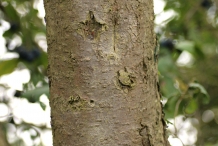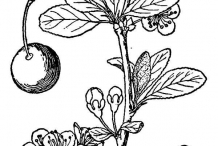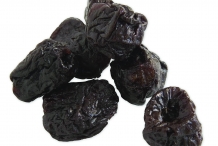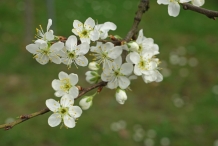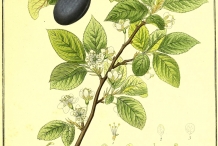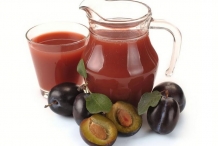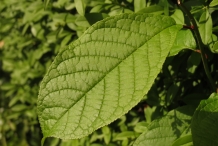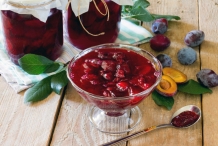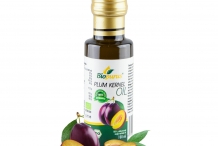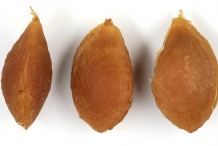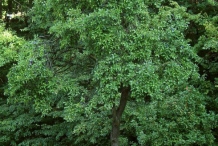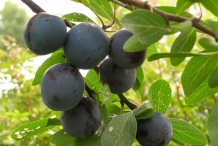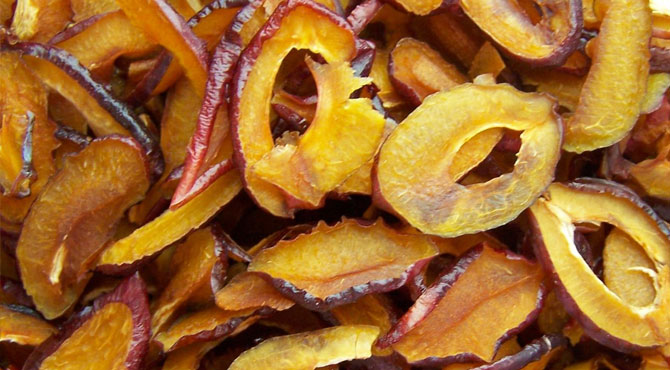Plums have high content of potassium, Vitamin K and C and are a great source of dietary fiber and is often consumed dried, fresh or is prepared into jams, preserves, juices and jellies. It is also used in puddings and baked goods and used as a condiment alongside meat dishes. It is used to make alcoholic beverages in Central and Eastern Europe including the plum brandy called slivovitz. Plums have chlorogenic, neochlorogenic acid and phenols which are phytonutrients. Both dry and fresh plums act as a natural laxative due to the presence of isatin and sorbitol which provides relief from constipation. It adds bulk and enhances the free movement of fecal matter through colon so that it prevents the chances of developing colon cancer. Soluble fiber helps to lower the level of cholesterol by eliminating excess buildup of cholesterol and prevent its proliferation.
History
Prune was originated in area of Asia Minor and Caucusus. The cultivars were reported to occur about 500 BC in Central Europe and were already known to Teutonic and Celtic tribes. The fruit was distributed by Romans in Central Europe. High quality of cultivars was originated after Middle Ages from Southeast Europe and was distributed by seventeenth century throughout Europe. It is cultivated globally in temperate to warm temperate regions in Central, South and Southeast Europe, West Asia, North Africa, Australia, North America, South Africa, New Zealand and South America. Prunus domestica is a hexaploid species but its origin is still not known. It is believed to be originated from Prunus spinosa and Prunus cerasifera.
Plant
Plum tree measures from 29 to 50 feet (9 to 15 m) in height with reddish to brown twigs having no or few spines. Twigs while young are pubescent, covered with downy and short hair. Leaves are oval to oblong in shape and measures 10 cm (4 inches) long with wavy or serrated margins. Flowers are white, five petalled which occurs singly or in two or three clusters. The plant bloom flowers in early spring. Fruit measures upto 8 cm (3 inches) long and is round to oval in shape. It has a hard and stony flattened pit with smooth or slightly pitted shell. The color of the fruit considerably varies across varieties which ranges from green to yellow to red to purple to black and is often with white waxy bloom on surface.
Fruit
Fruits are sweet, juicy and possess a tart taste. It is round having diameter of 8 cm. The color of the fruit varies according to its variety which could be red, blue, yellow or purple. The mature fruits have dusty to white coating that provides a glaucous appearance. This natural wax could be easily rubbed off.
Health Benefits of Prunes
Prunes are loaded with major nutrients such as carbohydrates, Vitamin A, several amino acids, Vitamin B complex, potassium, Vitamin K, magnesium, calcium, manganese, copper, zinc, dietary fiber and boron. Prunes fiber includes soluble fraction which includes hemicellulose, pectin, lignins and cellulose. The drying process promotes the total dietary fibers. Fructose, glucose, sorbitol and sucrose are primary simple sugars.
Prunes have ample amounts of flavonoid polyphenolic antioxidants such as cryptoxanthin, lutein which helps to scavenge free radicals which enters due to environmental toxins and poor eating habits. It leads to premature aging and cancer. It contains potassium which helps to formulate red blood cells, blood pressure and heart and Vitamin B6, niacin, Vitamin K, amino acid and pantothenic acid could also be found in it. Zeaxanthin and Vitamin A found in plums are good for eye health due to the presence of carotenoid that absorbs into retina and filters ultraviolet light. Vitamin C helps to protect cholesterol from damage made by free radicals and is helpful for the patients of atherosclerosis and diabetes.
- Prevent Hepatitis C
HCV is a Hepatitis C virus infection which results chronic liver diseases. Standard therapies have severe side effects, high expense and resistance development. The present study was conducted to evaluate fruits which are known for its hepatoprotective activities in order to know the inhibitors. Then it was reported that Prunus domestica acted as a new HCV entry inhibitor. The confirmation and characterization was performed by NMR, LC-ESI-MS and IR spectral analyses. Rutin inhibit HCV-LP significantly by binding to hepatoma cells and inhibits cell culture derived HCV entry into hepatoma cells. Moreover, rutin was non-toxic to hepatoma cells. It inhibit early stage of HCV lifecycle by directly acting on viral particle. (1)
- Eliminate free radicals
The intake of fruits such as prunes and plums is helpful for treatment of digestive disorder, measles, blood circulation disorder, diabetes, prevention of cancer and obesity. The study was conducted to know antioxidant and antiradical capacity of plum in both dried and fresh form. The findings shows that fresh ones are favorable in collecting oxygen free radicals such as peroxy radicals (ROO) and superoxide (O2-) in comparison to dried. (2)
- Bone health
Osteoporosis is a chronic age related disease which characterizes loss of bone in quality and mass and is also related with increase in chances of fragility fractures. Postmenopausal women have high chances of development of osteoporosis because of cessation in production of ovarian hormone which accelerates loss of bone. The lifestyle factors such as exercise and nutrition also lowers the chances of osteoporosis development and plays a vital role in bone health. The dried plum intervene the prevention and reversing structural loss and bone mass in rats as well as osteopenic postmenopausal women. The evidence was provided to show efficacy of dried plum to prevent and reverse bone loss related with ovarian hormone deficiency in humans and rodent models. The postmenopausal women who consumed 100 g of dried plum per day retain bone mineral density to a high extent in comparison to those who receive a comparative control. Moreover, possible mechanisms are highlighted by which bioactive compounds found in dried plum provide bone-protective effects. The study findings and other suggest that dried plum is an effective functional food therapy to prevent bone loss in postmenopausal women with long lasting bone protective effects. (3)
- Treatment for obesity
The evidence shows that nutritional interventions assist in treatment for obesity and most investigations utilized non-digestible carbohydrates only. Plum and peach has high content of polyphenols, compounds having demonstrated anti-obesity effects. An underlying process treats obesity successfully with the use of polyphenols which involves on an alteration of intestinal microbiota. (4)
- Cardiovascular problems
Plums as well as prunes have high content of phytonutrients known as phenols. It has high content of two unique phytonutrients such as chlorogenic acid and neochlorogenic acid. The study shows that phytonutrients assist in prevention of damage to cells in oxidation of lipid molecules in the body. Cell membranes and brain cells are made up of lipids that contain fat which are essential phytonutrients that is a must in diet. These compounds assist in inhibition of oxidation of LDL cholesterol in the body which makes it an essential factor to prevent chronic diseases.
- Lowers cholesterol
Soluble fiber assists to lower cholesterol by soaking excess bile in intestine and excreting it. Bile is formed from cholesterol found in liver to digest fat. The body when excretes bile with fiber from plums and prunes, the liver should use cholesterol in the body for making bile by lowering circulation in the body. Soluble fiber assists in inhibition of cholesterol amount produced by liver. The study shows that prunes effectively provide relief from constipation.
- Prevent constipation
Prunes has oxyphenisatin which acts as laxative. The high content of chlorogenic acids and sorbitol provides laxative effect of prunes. The study shows that an intake of yogurt which contains galactooligosaccharides, prune and linseed lowered constipation severity. The regular intake of prune juice provides mild laxative effect and significant lower in serum activities of serum alkaline phosphatase and alanine transaminase. Prune juice is effective for hepatic diseases. Prunes assist the body to digest food properly, have regular movement of bowel and provide relief from constipation. One prune provides 3% of recommended regular intake of fiber. Sorbitol found in prunes act as laxative as it pulls moisture into digestive tract and also facilitate bowel movements.
- Supports vision
Prunes have high content of Vitamin A. One serving of 25 grams of prunes provides 15% of RDA of this vital nutrient. Prunes provide Vitamin A in form of five carotenoids such as beta carotene, alpha carotene, beta cryptoxanthin, zeaxanthin and lutein. Alpha carotene, beta cryptoxanthin and beta carotene are converted in form of Vitamin A which is used by cells in eyes which converts light into nerve impulses. Zeaxanthin and lutein are found in retina where it protect cells from toxic blue light wavelengths and also lowers the chances of developing cataracts and macular degeneration.
- Acts as antioxidants
Prunes have high content of phytonutrients called phenols. It possess two phenols chlorogenic and neochlorogenic acid which have shown high effectiveness against free radicals especially superoxide anion radical. It damages fats in cell membranes, cholesterol molecules and brain cells so it neutralizes this free radical which supports protection of health. Moreover, prunes have high content of anthocyanins due to their rich purple hue. Anthocyanins and potent antioxidants contribute to liver function, heart health, arthritis relief and reduction in cholesterol with its anti-inflammatory activities.
- Lower cholesterol
Prunes assist one to manage weight by keeping full for longer time period. It has high content of fiber which take time to digest so that appetite stays satisfied for long period of time. Prunes have low glycemic index which raise the level of glucose (sugar) in the blood slowly. It is due to high content of sorbitol which is a sugar alcohol having slow absorption rate. It avoids spikes in level of blood sugar that are caused by foods having high glycemic index that keeps appetite at bay. The study shows that consumption of dried plums as a snack helps in suppressing hunger for longer in comparison to low fat cookie. Those who are on weight loss program should add prunes to the diet.
https://www.youtube.com/watch?v=ddTqfcIB2aE
Types of Prunes
• French
This is the high quality variety nowadays for consumer packs. The fresh fruit is medium-sized, egg-shaped. Skin is deep red to purplish; the flesh is good flavored, even, non-porous as well as golden yellow. The drying out percentage usually averages about 3:1, fresh to dry. The pit is little, even, flat, and also long-oval. Collect maturation are usually mid-season.
• Moyer
 Fruit is quite big when trees are usually clipped and is also oblong along with almost equal halves, and it has darkish reddish skin. Trees are usually vertical growers and therefore are incredibly energetic while youthful. These are efficient at showing large crops. Trees bloom about a couple of days after do French trees and therefore are gathered about 10 days later on. The drying proportion approaches 4:1. The majority of lucrative when utilized in specialized packs as well as fresh market deliveries.
Fruit is quite big when trees are usually clipped and is also oblong along with almost equal halves, and it has darkish reddish skin. Trees are usually vertical growers and therefore are incredibly energetic while youthful. These are efficient at showing large crops. Trees bloom about a couple of days after do French trees and therefore are gathered about 10 days later on. The drying proportion approaches 4:1. The majority of lucrative when utilized in specialized packs as well as fresh market deliveries.
• Tulare Giant
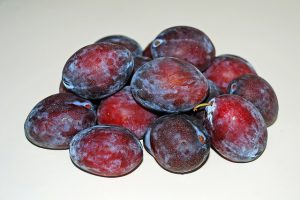 Most suitable for the fresh new marketplace. It really is big in dimensions, usually two times the dimensions of French. It has an earlier date of maturation, ripening within mid-July within an average year. The fruit is darkish purple to just about blue colored. The usage of this particular cultivar for drying out is limited-large pit size, drying time which is higher than 20 hours and also tendency to bleed as well as piece.
Most suitable for the fresh new marketplace. It really is big in dimensions, usually two times the dimensions of French. It has an earlier date of maturation, ripening within mid-July within an average year. The fruit is darkish purple to just about blue colored. The usage of this particular cultivar for drying out is limited-large pit size, drying time which is higher than 20 hours and also tendency to bleed as well as piece.
Traditional uses
- Dried prunes are used as a decoction and are mildly laxative.
- Prepare a tincture from fresh flower buds.
- The oil extracted from the kernel of plum is used for alimentary purposes.
- For centuries, it has been used to treat digestive complaints.
- Prunes are used for vomiting, nausea, acid dyspepsia, lower thirst, headache and bilious fevers.
- It also soothes stomach.
- Prunes are also used as a treatment for leucorrhea, dysmenorrhea, fever, asthma and miscarriage.
Precautions
- Its excess use causes respiratory failure or even death.
- It should not be used by diabetic patients, allergic people and nursing mothers.
- Too much intake of prunes causes gastrointestinal distress because of high sorbitol and fiber.
How to Eat
- Dried prunes should be soaked in hot water before cooking.
- Serve the stewed prunes with rosemary scented braised lamb.
- Serve prunes on the top of waffles and pancakes.
- Mix diced dried prunes with dried nuts and fruits to make a homemade trail mix.
- It is made into preserves, jams, muffins, breads and pastry.
- The juice of plum could be fermented into wines.
- Flowers of plum are also consumed and used as a garnish for ice cream, salads.
- It is brewed into tea, jam and also dried.
- The intake of prunes is helpful for measles, blood circulation problems, cancer prevention, digestive problems, obesity and diabetes.
- Prunes are used to prepare savory and sweet dishes.
- Stewed prunes are used as desserts.
- It is used as ingredients in North Africa, consumed with rice pudding in Nordic prune kisel and also in traditional Norwegian dessert fruit soup.
- The fruit is also used in cakes and stuffing.
- It is also added to yogurts, pastries, ice cream and also used to make juice.
- In Europe, kompot is a traditional drink made from prunes.
Other Facts
- Dyes of dark grey, green and yellow color could be obtained from fruit, leaves and bark respectively.
- The grounded seeds are used for producing face masks for dry skin.
- The woods are used to make musical instruments.
- Prunes are a great source of fiber which lowers the chances of certain cancer.
References:
https://www.itis.gov/servlet/SingleRpt/SingleRpt?search_topic=TSN&search_value=24774#null
http://www.pfaf.org/user/Plant.aspx?LatinName=prunus+domestica
http://www.missouribotanicalgarden.org/PlantFinder/PlantFinderDetails.aspx?kempercode=n300
http://www.floracatalana.net/prunus-domestica-l
http://www.botanical.com/botanical/mgmh/p/prunes72.html
https://en.wikipedia.org/wiki/Prune
https://www.tarladalal.com/glossary-prunes-1602i
http://foodfacts.mercola.com/plums-and-prunes.html
https://static8.enetural.com/static/ameixas_27210.pdf
https://www.healthline.com/health/food-nutrition/top-benefits-of-prunes-prune-juice#appetite10
https://www.indigo-herbs.co.uk/natural-health-guide/benefits/prunes
Comments
| Prune Quick Facts | |
|---|---|
| Name: | Prune |
| Scientific Name: | Prunus domestica |
| Origin | It is cultivated in temperate areas for its fruit worldwide. |
| Colors | Green, yellow, red, purple, black |
| Shapes | Round to oval drupe, 8 cm (3 in) long |
| Flesh colors | Translucent |
| Calories | 418 Kcal./cup |
| Major nutrients | Vitamin K (86.25%) Carbohydrate (85.50%) Copper (54.33%) Total dietary Fiber (32.63%) Vitamin B6 27.46%) |
| Health benefits | Prevent Hepatitis C, Eliminate free radicals, Bone health, Treatment for obesity, Cardiovascular problems |
| Name | Prune |
|---|---|
| Scientific Name | Prunus domestica |
| Native | It is cultivated in temperate areas for its fruit worldwide. |
| Common/English Name | Common Plum, Gage, European Plum, Garden Plum, Prune, Plum, Prune Plum |
| Name in Other Languages | Afrikaans: Pruim; Arabic: Barqûq, Iggâss; Armenian: Salor; Basque: Aran; Brazil: Ameixa-Comum, Ameixa-Preta, Ameixa-Européia, Ameixa-Vermela, Ameixa-Roxa; Bosnian: Šljiva; Chinese: Li Zi, Ou Zhou Li, Mei Zi; Croatian: Šljiva; Czech: Sliva; Catalan: Pruner, Prunera; Danish: Blomme; Dutch: Pruim, Pruimenboom; Eastonian: Aedploomipuu, Ploom, Harilik Ploomipuu, Ploomipuu; Esperanto: Pruno; Finnish: Luumupuu, Luumu; French: Prunier, Prunier Domestique, Prunier Commun, Prunier Cultivé; German: Bauernp fl aume, Hausp fl aume, Echte P fl aume, Kultur-P fl aume, P fl aumenbaum, P fl aume, Zwetschge, Zwetsche, Zwispeln; Greek: Damáskino; Hebrew: Shazif; Hungarian: Kerti Szilva, Szilva; Icelandic: Plóma; Italian: Prugna, Prugno, Pruno, Susina, Susino; India:- Hindu: Alu Bukhara, Malayalam: Arukam, Manipuri: Heikha, Telugu: Alpagodapandu, Urdu: Aalu Bukhara; Indonesia: Plum; Japanese: Seiyou Sumomo, Puramu, Seiyou Sumomo, Yooroppa Sumomo; Latvian: Plūme; Malaysia: Plum; Nepalese: Alu Bakhara, Aalu Bakharaa; Occitan: Prunièr, Prüèra, Prüèr; Persian: Aalu; Polish: Šliwa Domowa, Shliwa Domowa, Śliwka; Portuguese: Abrunheiro, Abrunho, Abrunheiro-Manso, Agruñeiro, Ameixeira, Ameixa, Ameixoeira; Roman: Šljiva; Russian: Sliva Domašnaja; Scots: Ploum; Serbian: Šljiva; Slovakian: Slivka, Bystrické Slivky, Slivky; Slovenian: Cheshplja, Češplja, Sliva; Spanish: Ciruela, Pruna, Ciruelo, Pruno, Prunero; Swedish: Plommon; Turkish: Erik; Vietnamese: (Trái) Mận, (Quả) Mận; West Frisian: Prom; Zulu: Umplaamuzi; |
| Plant Growth Habit | Deciduous |
| Growing Climate | Temperate |
| Soil | Sunny well-drained, fertile |
| Plant Size | 9 to 15 m (29-50 ft) tall |
| Leaves | Oval to oblong, 10 cm (4 in) long |
| Flowering Season | Early spring |
| Flower | White, green, yellow, red, purple, black, solitary |
| Fruit shape & size | Round to oval drupe, 8 cm (3 in) long |
| Flesh color | Translucent |
| Major Nutritions | Vitamin K (phylloquinone) 103.5 µg (86.25%) Carbohydrate 111.15 g (85.50%) Copper, Cu 0.489 mg (54.33%) Total dietary Fiber 12.4 g (32.63%) Vitamin B6 (Pyridoxine) 0.357 mg (27.46%) Potassium, K 1274 mg (27.11%) Vitamin B2 (Riboflavin) 0.324 mg (24.92%) Manganese, Mn 0.52 mg (22.61%) Vitamin B3 (Niacin) 3.275 mg (20.47%) Iron, Fe 1.62 mg (20.25%) |
| Calories in 1 cup, pitted (174 g) | 418 Kcal. |



